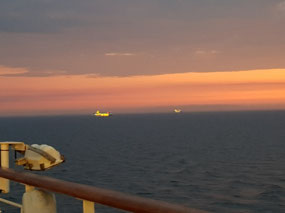Most
people were happy to sleep in on this ‘at sea’ day. We had the Mariners Brunch
at 11 am so did not even have breakfast. I did go to the session about the next
2 ports before this though.
The
Brunch was really lunch and included free wine and coasters. I went to the
America’s Test Kitchen display on steak meals after this, not feeling hungry at
all.
The
highlight of the main part of the day was the Captains Talk. He used a mock-up
of the bridge to explain the major pieces of equipment, and also had a video
showing the stabilisers, the bow thrusters and the arizport (sp) which pulls rather
than pushes the ship through the sea. He mentioned the various top ranks and
that 4 people were always on the bridge at any time. If the sea conditions are
poor, there is fog or a lot of traffic, the level increase and the number of
people on the bridge does as well.
The best
part was his answer to the questions from the floor.
He said
he sometimes gets a cadet to lower and raise the flag when passing a naval
vessel and then watches the fun.
The protocol if you are greeted like this is
to return the greeting so the passing ship has to scurry to do so. He was asked about pilots and why they are
needed and said often they are mandatory but often useless. In these cases, the
pilot is given a coffee and the crew do all the work. But he said in many
places (like NZ) they can give useful information about recent tidal changes
that make a slight alteration to the approach very worthwhile.
Various
questions were asked about food waste and water. The ship can process waste to
a potable standard and this can be discharged outside the 12-mile limit.
He told
us that when we left Copenhagen the tide was such that we could go through the
Drogen Channel but with .7m clearance (which was why we slowed to 5 knots).
This saved 254 nautical miles of sailing and was the reason we were so early
into Tallinn.
The
Captain had worked on cargo ships and had interesting stories from that time.
In pirate prone waters they would go fast and, illegally, turn off all lights
at night. HAL ships have been accompanied by Dutch frigates. His most scary
moment had been on the Tasman sea, taking huge tyres etc. from Australia to NZ.
In high seas the lashings had broken and he was part of the crew trying to
relash them so they were not rolling around. The Captain was drunk and refused
to lower speed or change course. He added that an hour later the Captain passed
out and he and others could take charge of the bridge and lower speed. He did
say the Captain was dismissed soon after this
He was
asked if there were any women Captains in the fleet and said no. He added
however, that a NZ woman had reached Staff Captain level (one below) but had
moved to another job, and that there was a woman in the ranks who was likely to
be a Captain in a few years.
The final
question caused a laugh as did his reply. A woman asked what happens if people
are not back on board when the ship departs. His reply was that we should ask
the family that would be re-joining us tomorrow. He then elaborated and I was
surprised at the flexibility that they might have. If the ship knows how far
away a group are they may be able to wait, if it is not far. It also depends on
tides etc. as the Captain may just have to go to get the right tides. Finally,
he said that the sail away scheduled was also a factor as he had over 1000
passengers waiting for the views and commentary (that got a round of applause),
His final comment was that the family concerned arrived at the port 45 minutes
late, to be greeted by the agent who helped ensure they could get accommodation
for the unexpected stay and transport to Rostock – at their own expense we
assumed.
We met
Alex and Warwick by the pool at one stage and then later over our Gala Dinner.
We all ordered the surf and turf which was very tender. Warwick had had a win
at cards (500 euros) so was celebrating that as well. Then I went to the show
which was fine, but not wonderful, before we called it a night.













2025-05-22